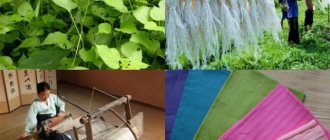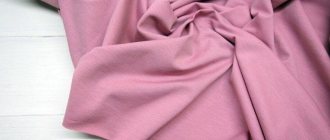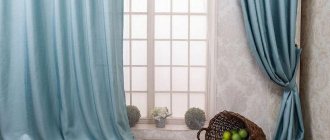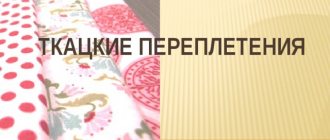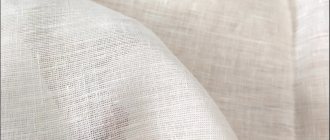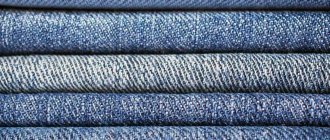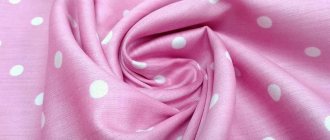Ramie fabric, composition and properties
Recently, there are more and more people wanting to buy clothes made from ramie.
This fabric has won the love of many, especially those who belong to the progressive part of society and strive to improve the environmental situation not only in the world, but also in everyday life. Clothes made from ramie.. For the vast majority of people, the phrase “fabric made from nettles” evokes a feeling of fear rather than positive emotions. And in vain!
We will tell you about such a unique discovery of humanity as ramie - the so-called Asian or Chinese nettle. Although this discovery is no longer a century old, not everyone knows about all the wonderful properties of this plant.
Ramie is a perennial plant used in medicine, paper making, weaving, etc. Cultivated in 2 types: green and white fiber. The length of the plant stems reaches two and a half meters. Traditionally, the crop is harvested up to 6 times a year. Harvesting requires a lot of work, so ramie can easily be considered one of the most noble fibers.
The fibers of this plant have a fairly high strength, which especially attracts designers and technologists. The tensile strength of this fiber can be approximately seven times that of cotton and silk! An important role in this indicator will be played by how carefully they approached growing the plant and obtaining fiber at the time.
The fiber has a natural white color and glossy shine, which is so appreciated by lovers of ramie fabrics. At the same time, unlike silk, which can lose its appearance when exposed to sunlight, nettle fabrics do not lose their shine at all.
Another feature is that the fiber does not rot, is not prone to corrosion and is resistant to insect attacks. This allows you to protect the plant from chemical treatments and obtain the most environmentally friendly raw materials. Moreover, recent studies have shown that planting the ramie plant itself can save the soil from erosion. So the ecological role of this plant takes place in all periods of its existence: from planting to the use of its fibers in fabrics and the manufacture of products from these fabrics.
Speaking of products... Due to its advantages, fabric containing ramie fibers has found its application in home textiles, children's and adult clothing, accessories, bed linen, curtains, tablecloths, tapestries and many others.
Recently, there are more and more people wanting to buy clothes made from ramie. This fabric has won the love of many, especially those who belong to the progressive part of society and strive to improve the environmental situation not only in the world, but also in everyday life. Clothes made from ramie allow the body to “breathe”; the fiber perfectly absorbs moisture and dries quickly, thereby maintaining a slight feeling of coolness. This makes such clothes very comfortable, especially in the warm season. One of the properties of ramie fabric is natural antistatic. In addition, the fabric washes well, can be washed without difficulty and does not lose its appearance after drying. Some even claim that clothes become even brighter after washing.
There is one more useful property that deserves a separate topic. Ramie has antibacterial properties and prevents the proliferation of various unwanted microorganisms and fungi. Thanks to this, ramie is a valuable fabric for the production of children's clothing and bed linen.
The low elasticity coefficient of the fiber is perhaps the only drawback when using it in clothing. But the composition of ramie fabric is often combined with other fibers, resulting in unique fabrics. For example, a wool product will shrink less if it contains ramie fibers. Also, ramie imparts strength to viscose materials, which a priori have low strength. Mixing ramie with other fibers allows you to create durable, wear-resistant, shape-resistant products with interesting color schemes, because ramie is very easy to dye.
Nowadays ramie is used mainly in luxury fabrics, because this natural fiber, which is not obtained in the easiest way, has a lot of useful properties. The main producers of ramie fabrics are: China (occupies most of the market), South Korea, the Philippines, India, Brazil and Thailand. And in Korea, in honor of ramie, they even hold an annual festival, which attracts the best designers specializing in environmentally friendly clothing. There is a fashion show at the festival, and the clothes on the models are made from ramie fabrics. Also, a fair of these wonderful outfits is organized at the festival.
For those who value eco-fabrics, care about their health and comfort, and for those who simply follow the trend, ramie fabrics have already become a pleasant discovery and have taken their strong place in everyday life. Everything you learned about ramie today is not all that can be said about it. From generation to generation, since the time of the Scythians, ramie has been used by humanity and confirms its right to a rightful “place in the sun” among other fabrics!
Irina Zadorozhnaya.
Assortment of ramie fabrics in the catalog of the EcoFabrics store:
ramie fabrics (from nettle)
Ramie fabric Blue-blue sky
Nettle fabric, delicate natural shade
Beautiful red nettle fabric
Ramie fabric, shimmering mint
Rami
Ramie fibers resemble linen and have long been used in the East, especially in China and Japan. Relatively recently, ramie fiber began to be used in other countries of the world. It is durable, shiny and wash-resistant, but somewhat stiff and not very resilient.
This is interesting. Ramie is a Chinese nettle. It belongs to the oldest types of raw materials used for the production of fibers, and not only textile ones. Nettle has been cultivated for more than fifty centuries.
Initially, ramie fiber yarn was spun into very long threads. Then the finest fabrics were made from them by hand. They turned out light, silky, reminiscent of linen. After some time, ramie threads began to be used for weaving and knitting. Yarn based on Chinese nettle fibers can be a substitute for linen, and it is often cheaper.
How is this yarn made?
The nettle stems are dried until a ready-to-use fiber is obtained. It is then spun into yarn, which is almost no different from other types based on plant fibers. As a rule, 100% ramie yarn does not exist. Its fibers are mixed with others so that the knitted item can be worn for a long time and comfortably.
Material properties
Ramie yarn without additives is white and shiny like silk, but is rough. The fibers are long, have almost no stretch, but in strength they can compete with many other types, even synthetic ones. The wear resistance of ramie is very high. For example, compared to cotton, it is more than five times higher. The yarn dyes well and does not lose its shine. Products made from ramie quickly absorb moisture and dry, so they are comfortable to wear even in hot weather. Items made from such yarn hold their shape for a long time and do not shrink, but can wrinkle if stored carelessly.
Rules of care
Items made from ramie can be safely ironed and machine washed even at high temperatures, unless the manufacturer indicates otherwise on the label. It is permissible to dry them laid out on an oilcloth or towel on a flat horizontal surface, since ramie products wrinkle easily. Long drying in the sun should be avoided - under the influence of ultraviolet radiation, natural fibers lose their properties. Knitted items should be stored carefully, on soft hangers or carefully folded, remembering that the fabric wrinkles.
Advice. Do not soak ramie items, especially colored ones, as they may fade. Also avoid boiling to prevent the threads from becoming dull.
What to knit
Summer items are usually knitted from yarn with the addition of ramie: lace tops, cardigans, tunics, light capes, beach dresses for swimsuits. Chinese nettle fibers are often mixed with cashmere, silk or cotton.
Collections
There are many varieties of yarn that contain ramie fibers. For example, cashmere and bamboo go well with them. Ramie gives the yarn silkiness, cashmere gives it softness, and bamboo gives it elasticity. The products are original, comfortable and almost wrinkle-free. Chinese nettle fibers can also be added to viscose yarn - this combination makes the threads strong and at the same time elastic. Products made from wool with ramie are lightweight, shrink less than pure wool, and hold their shape well. The label always indicates the composition and gives advice on caring for knitted items.
Ramie is an eco-fabric made from Chinese nettle. Miracle of East Asia
Trends in using eco-friendly materials have opened up an interesting new product for fashionistas - ramie fabric. Today, it is used to create clothes for everyday life that bring indescribable delight. Few people know that humanity has been dressing in ramie since ancient times.
Ramie - ramie or Boehmeria nivea - Chinese nettle, a plant of the nettle family, growing in Asia. Its main advantage is its 100% strength. If you compare ramie fabrics with linen or cotton textiles, it turns out that nettle breaks all records. She is not afraid of tears or torsion. That is why in ancient times ropes and sails were made from ramie.
Another feature is its resistance to rotting. Ramie can be moistened with water, left for many days in high humidity conditions, and remain confident that nothing will harm her. But what is even more interesting (and even looks fantastic) is that when dyed, nettle does not lose its silkiness.
A little history about the occurrence of a miracle
In fact, there is no miracle here. Ancient people, wanting to get strong protection from cold and bad weather, looked for ways to hide their nakedness. They tried a variety of plants, wove ropes, and extracted roots. Plants were turned into fibers, which turned into textiles of varying strengths. The properties of nettle were discovered through trial and error. It was used in China, Japan, India - many places.
In Mexico, ramie was valued for its silky sheen. In England and the Netherlands, the wonderful fabric from the island of Java was idolized for its super-strength. For a long time, nettle textiles remained in the shadows, as there were difficulties in its production - this activity was too labor-intensive, it required perseverance, manual work, and countries where machine tools ruled were not ready for this. But today ramie is coming back into fashion.
Where to buy ramie in Russia?
In Russia, they are just taking a closer look at ramie. Russian designers also give preference to more popular textiles, but still look towards miracle new items. So far, nettle fabric can only be purchased from foreign suppliers through foreign resources. Clothes from ramie are made by a few craftsmen, about whom we will tell you later.
Comments
Want to stay up to date with the latest publications? Subscribe to our Telegram channel
DESIGNERS FROM RUSSIA
EDITORIAL OF THE NETWORK EDITION
For all questions of cooperation, write: [email protected] We are on Instagram: @designersfromrussia #designersfromrussia #dfr
Previous Article
Presentation of the Viktoria Fleur brand collection
Next Article
Fashion Producer Louise Avier: “Give up the words ‘it’s impossible’!”
RAMI
RAMI, Boehmeria, a genus of perennial herbaceous, woody shrub and semi-shrub plants of the nettle family. The spinning culture has been known for more than 6 thousand years. Includes 75 species native to China and Japan, mainly growing in the tropics and subtropics of East Asia. The leading producers of R. fiber are China, Japan, the Philippines and Brazil. Two species are cultivated - R. white, or Chinese nettle (B. nivea), mainly growing in subtropical zones, and R. green (B. tenacisima), or Indian nettle, mainly in the tropics. R. white is a spinning crop originally from China. The plant is rhizomatous, with a powerful root system; forms a bush of 5–20 annually dying shoots. The stems are unbranched (up to 3 m high), the leaves are heart-shaped (7–15 cm long and 6–12 cm wide), the underside of the leaves is pubescent, which is why it looks white. The flowers are unisexual, small, green or pinkish; in multi-flowered inflorescences - panicles located in the axils of the upper leaves (female flowers are formed in the upper part of the inflorescence, male flowers - in the lower). The fruit is a very small, oblong achene, pubescent with hairs. The culture is very demanding of heat and moisture. Cultivated on fertile and loose soils. R. green is also cultivated for fiber (the species are closely related, but this species lacks pubescence on the underside of the leaf). R. fiber has luster, fineness, a long length of elementary fibers (6–40 cm), it is elastic, resistant to moisture (almost resistant to shrinkage and stretching) and rotting, and is weaker than other fibers when interacting with chemicals; 4 times stronger than linen. R. fiber is used for the production of linen and technical fabrics, packaging materials, fishing nets, etc. In the manufacture of clothing, R. is often used in a mixture with other textile fibers (for example, wool, which can significantly reduce fabric shrinkage). High-quality paper is also obtained from R. R. produces 2–3 harvests per year, less often – up to 6. With proper cultivation of R., high yields are maintained for 20–30 years. The fiber is collected immediately before or shortly after flowering begins. The fiber yield is about 1 t/ha in the 3rd year of plantation use and increases to 1.5 t/ha in the 4th year. The yield of dry bast is 2.5–3% of the green mass of the stems. China leads in fiber production (according to FAO, in 2014 - 108.7 thousand tons out of 112.8 thousand tons of total world production) and exports fiber mainly to Japan and Europe. The main importers of R. fiber are Japan, Germany, France, and Great Britain. In some countries (Colombia, Cuba) R. white is cultivated for feed purposes. It is also grown as an ornamental plant; in Vietnam, R. leaves are used in national cuisine. R. is propagated mainly by rhizomes; Reproduction is also possible by seeds, layering and stem cuttings.
Description of the plant
Cultivated in China. The leaves are large, jagged, heart-shaped, and covered with white hairs that impart a silvery sheen. The homeland of the green damselfish is the Malay Peninsula. The plant has smaller leaves, green underneath, and is cultivated in tropical conditions.
Product made of material
The plant, which grows in northern climates, is characterized by short and coarse fiber. It is for this reason that the plant, cultivated in temperate latitudes, has found wide application in the manufacture of materials used for household needs. At the same time, fiber, white nettle and the related genus Boehmeria tenacissima have been grown in southern Asia for 5 thousand years. The fabrics produced from plant materials are white and green ramie.
There is a ramie museum in South Korea, where the fabric is called "moshi".
Ramie Museum
According to historical information, the Chinese used nettles as a raw material for making outerwear - kimonos. The traditional clothing of Korea, the hanbok, made of linen, was popular because of its grace. The fabric combines lightness and silkiness, is in many ways similar to linen, and is used in the production of clothing and home textiles.
If plant raw materials are processed incorrectly, the chance of obtaining low-quality fabric increases. Fabric produced in China and India is especially valued. These countries have centuries of experience in growing and processing the plant.
The canvas was brought to Europe by travelers. In the 19th century Large-scale cultivation of nettles began in Europe, and fabric production was organized in some countries. In the Caucasus, the plant is cultivated and raw materials are produced. The plant is not grown on the territory of the Russian Federation.
Modern look of the material
Rami Festival in Korea
In Korea, a festival dedicated to ramie is held annually. Ramie fiber is called "mosi" in Korea. This festival takes place in Hansan during the summer. The most attractive component of this interesting and colorful event is the traditional fashion show of professional models in outfits made from ramie fabrics. And the fair, where you can purchase, among other things, your favorite products from the fashion show, every year brings together buyers from all over the planet. It is here that you can easily meet world-famous couturiers, members of multimillionaire families, sheikhs, Hollywood stars, and world-famous opera divas. Clothes made from ramie are not only very comfortable, but also very status-worthy!
